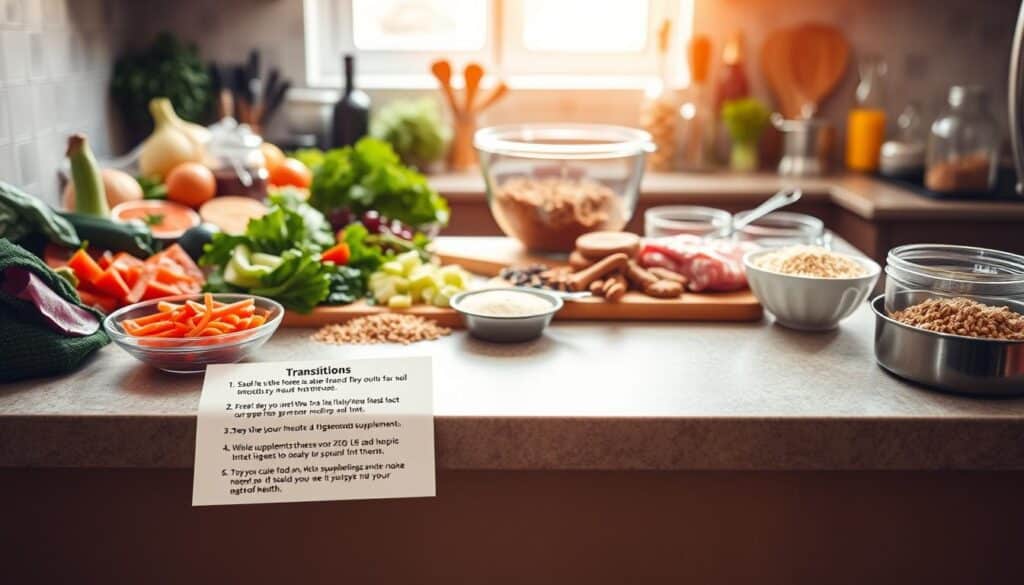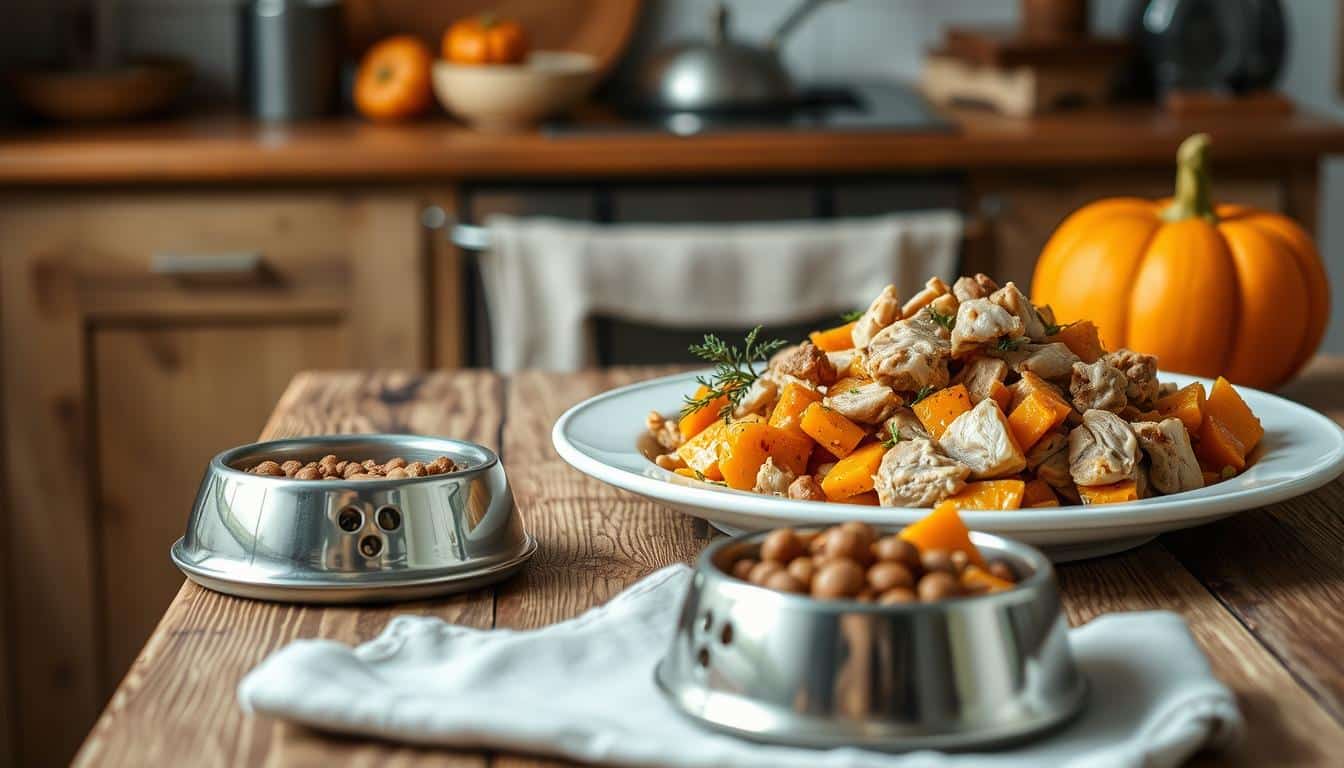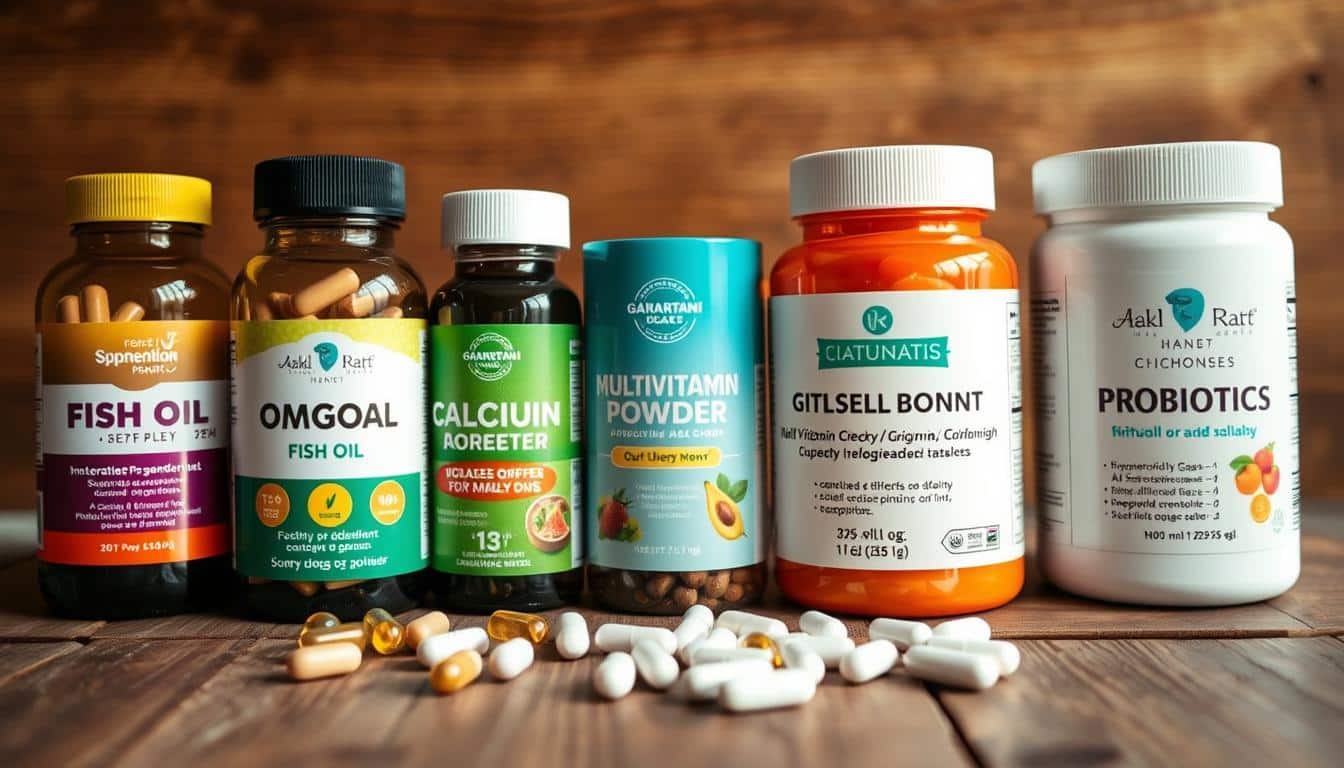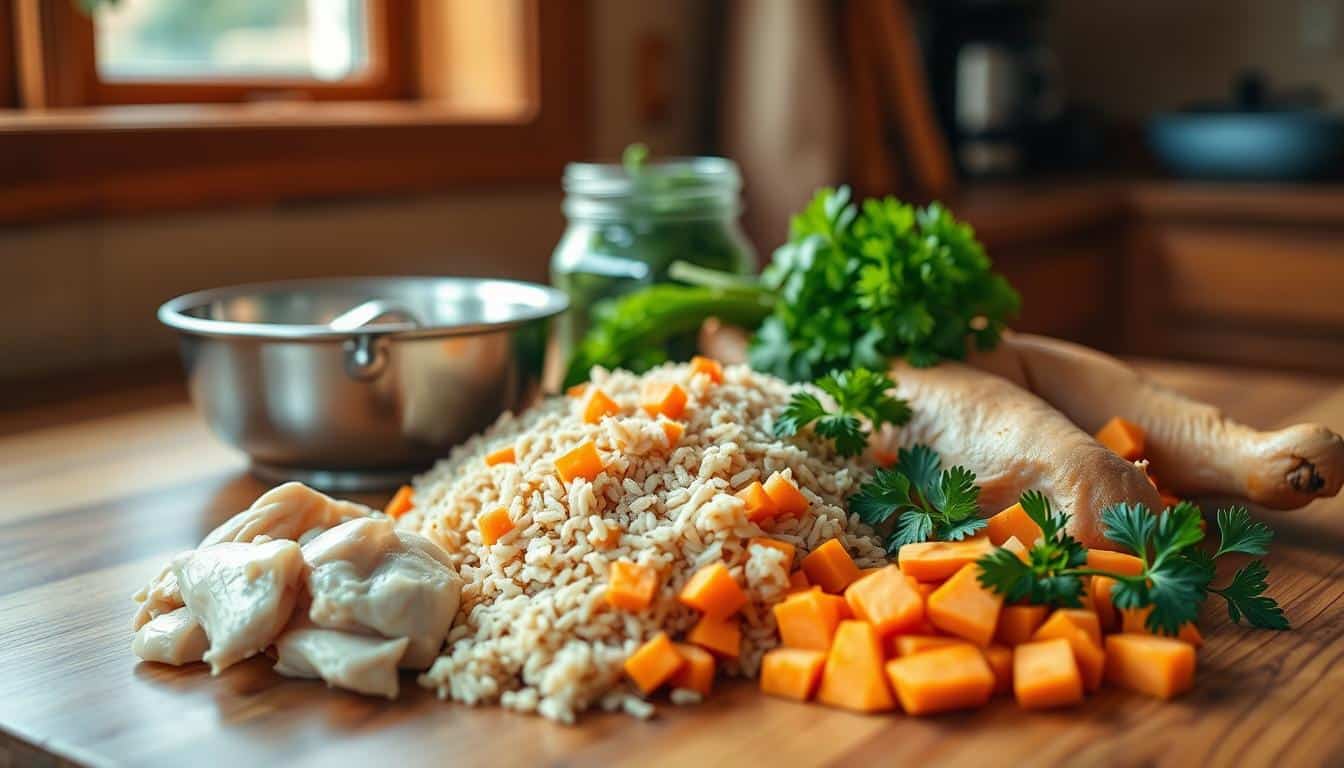Before switching your small dog to homemade food, talk with your vet or an ACVN nutritionist. The internet has many recipes, but they might not be right. They can suggest recipes that fit your dog’s needs, based on their age, breed, weight, and health. Do not feed homemade diets to puppies under one year, or to pregnant or nursing dogs, without expert advice.
This guide focuses on what your dog needs: protein, the ten essential amino acids, fats, carbohydrates, and fiber. It also covers important minerals like calcium, phosphorus, zinc, and iodine. Remember, always give your dog fresh water since homemade meals alone aren’t enough.
Many switch to homemade food due to recalls or to manage ingredient quality. For most small dogs, a starting plan is about 40% protein, 50% veggies, and 10% starch. But each dog is different, so work closely with your vet. They can recommend supplements or commercial mixes to make sure your dog gets proper nutrition.
When moving to homemade food, pick high-quality ingredients and check their freshness. Change their diet slowly over 5–7 days, or more for dogs with sensitive stomachs. Watch their weight and how they react. Use resources like the ACVN directory, Tufts Cummings Clinical Nutrition Service, and BalanceIT. They can help you make safe, long-term meals for your pet.
Why Owners Choose Homemade Meals for Small Dogs: Benefits and Risks
Many pet owners prefer homemade diets for fresher options and to meet their dog’s specific needs. Fresh food for small dogs offers diverse tastes and textures that picky eaters love. It lets owners choose high-quality ingredients, like lean meats, good fats, and veggies high in fiber.
Benefits of home-cooked diets
Home-cooked meals help manage weight with carefully measured portions. They boost appetite, thanks to the fresh ingredients and variety of flavors. This makes mealtime more appealing.
Homemade dog food is great for controlling allergies or food issues. Owners can avoid harmful ingredients and pick healthier options, keeping an eye on sodium and calories.
- Control over sourcing and processing helps ensure safer produce and proteins.
- Ability to tailor calorie density and portion size for small breed metabolisms.
- Easy to mix with kibble or toppers to encourage fussy eaters.
However, experts caution about using just any recipe off the internet. These may lack vital vitamins and minerals. The American College of Veterinary Nutrition suggests getting personalized plans. They should fit the dog’s age, weight, and health to prevent nutrient imbalance.
Owners may switch to homemade meals due to recalls or shortages of commercial foods. It can also be part of a rotation diet, given it’s balanced and vet-approved.
Some risks include nutritional gaps, overfeeding, and upset stomachs when switching foods. To avoid these, owners should get guidance from vets on supplements and portions before going fully homemade.
How to switch small dogs to homemade food
Starting homemade meals for a small dog needs careful thought and advice from experts. First, chat with your usual vet and, if you can, a vet nutritionist. Look for a qualified nutritionist through the ACVN for professional advice. This helps avoid missing nutrients and tailors the diet to your dog’s specific needs.
Then, choose between switching completely or mixing homemade food with store-bought kibble. Mixing both can help your dog’s stomach adjust and makes keeping track easier. If you must switch quickly due to a recall, check with your vet first.
Consulting professionals before you start
- Talk to a vet nutritionist for custom advice and to go over ingredients.
- Discuss tests, checking your dog’s body condition, and regular check-ins to tweak recipes.
- Look into online meetings with an ACVN nutritionist if there are none nearby.
Assessing your dog’s individual needs
- Write down your dog’s weight, age, breed, how active they are, and health history before planning their diet.
- Think about if their age or needs, like growing or being pregnant, change their dietary needs.
- Keep an eye on their weight and adjust food amounts accordingly, weighing them every 1 to 4 weeks.
Planning a balanced, long-term recipe
For long-term success, get a diet plan approved by a vet, not something unproven from the internet. Professional services, like those from BalanceIT or university nutrition departments, can provide complete nutrition. BalanceIT helps create detailed plans that meet all your dog’s nutritional needs.
Start with basic nutrient ratios and tweak as needed. Most start with 40% protein, 50% veggies, and 10% carbs. Your vet can advise on any needed vitamins or minerals.
As you plan your dog’s homemade diet, track recipes, amounts, and supplements. Have regular vet visits and possibly redo blood tests to ensure the diet is providing all necessary nutrients. With careful planning and expert help, your small dog can thrive on a homemade diet.
Essential nutrients for small dogs: proteins, fats, carbs, vitamins, and minerals
Small dogs need special nutrients to keep them active and healthy. Make sure homemade meals have everything they need, like good energy sources and nutrients for growth. It’s important to serve the right amount for their size and age and check with a vet for their specific needs.
Protein requirements and safe sources
Dogs need protein that has all ten essential amino acids. You can feed them lean meats like chicken or turkey (without skin and bones) and certain kinds of fish like salmon. Remember to adjust the protein amount based on their age and health issues, and ask a vet about how much they need each day.
Fats and fatty acids
Fats are crucial for energy and keeping dogs’ skin and coats shiny. You can find good fats in animal products, fish oil, and some plant oils. Omega-3 and omega-6 are important for their health, but make sure not to give too much to avoid stomach problems.
Carbohydrates and fiber sources
Whole grains and certain veggies provide carbs for energy and fiber for digestion. You can include foods like rice, oatmeal, and quinoa, plus veggies and fruits for fiber. Always keep an eye on how these changes affect their digestion.
Key vitamins and minerals to monitor
- Vitamins A, B-complex, C, D, E, K, and choline are essential. Both too little and too much can be harmful.
- For strong bones and muscles, dogs need minerals like calcium and magnesium. They also need iron and zinc for their blood and immune system.
- It’s important to balance calcium and phosphorus, especially in puppies. Too much calcium or vitamin D can lead to bone problems.
Practical tips
- Change foods slowly to avoid upsetting your dog’s stomach.
- Always have fresh water available; homemade food doesn’t cover their water needs.
- For safe feeding, work with a vet nutritionist to check supplements and nutrient levels.
Building recipes and portion guides tailored for small breeds
Making meals for small dogs is about knowing the right mix and how much to feed. Stick to vet-approved recipes that give you clear amounts. Look into sites like BalanceIT or plans made by ACVN to avoid missing nutrients. Watch your dog’s weight and poop to adjust as needed.
General macronutrient ratio guidance
Start with good amounts of lean protein, veggies, and a bit of starch. Experts often recommend ratios around 40% protein, 50% veggies, and 10% starch. Adjust these ratios based on your dog’s age, how active they are, and their health. Add supplements for calcium and other nutrients as your vet says.
Portion sizing and calorie estimation for small dogs
To figure out what your small dog needs every day, start with their weight and how active they are. Then, use formulas or your vet’s advice to calculate the calories. Measure food with a kitchen scale to be precise. Every two weeks, adjust the food amount based on how your dog looks and feels.
- First estimate the resting energy needs, then factor in their activity level.
- Lower the calories and add more fiber for a weight-loss plan; increase healthy fats for active dogs.
- Using some commercial kibble can make controlling calories easier when switching foods.
Recipe examples and safe substitutions
Example recipes for dogs often mix cooked lean meats with things like cooked rice or sweet potatoes, steamed veggies, and a specific oil and calcium supplement. Always follow the recipes closely and don’t make changes that could throw off the nutrition balance.
- A simple mix: cooked chicken breast, sweet potato, green beans, fish oil, and calcium supplement your vet recommends.
- For more energy: ground turkey, brown rice, peas, olive oil, and dog multivitamin.
- Low-calorie option: lean fish, pumpkin, spinach, flaxseed, and a fiber boost as your vet suggests.
It’s okay to replace chicken with turkey or lean beef for white fish as long as it fits the protein needs. For starch changes, cooked quinoa or sweet potato works if amounts stay the same. Double-check these changes to keep nutrient levels right.
Keep a feeding log to remember what and how much you feed. Regular check-ins with a vet nutritionist lower risks and help fine-tune your feeding plan for your small dog’s health.
Safe ingredients and foods to avoid
When making homemade meals, balance nutrition and safety. Start with a list of safe human foods for dogs. Add foods that dogs must never eat. This way, your meals will boost growth, energy, and health safely.
Dog-safe human foods and beneficial add-ins
Lean proteins like cooked chicken, turkey, beef, lamb, and some fish are great. Make sure to remove the skin, bones, and extra fat first.
Eggs can boost protein when cooked. Plain yogurt, cottage cheese, and kefir are good for some dogs. They must tolerate dairy, though.
- Vegetables: carrots, cooked pumpkin, green beans, and dark leafy greens.
- Fruits: apples without seeds, blueberries, and small amounts of banana.
- Healthy oils: fish oil and flaxseed oil add omega-3s for skin and coat.
- Other add-ins: plain canned salmon, fully cooked shrimp (peeled), unsalted peanut butter in moderation, and small amounts of honey.
Use dog diet add-ins like fish oil or cooked eggs carefully. Watch portion sizes to avoid weight gain. Always track your dog’s reaction to new foods.
Foods and additives that are toxic or unsafe for dogs
Keep dangerous foods away from dogs. Toxic foods include chocolate, grapes, raisins, onions, garlic, and xylitol items.
Avoid feeding macadamia nuts, alcohol, raw yeast dough, wild mushrooms, and salty or seasoned foods. Processed meats like ham or bacon are not good either.
- Never feed: chocolate, grapes/raisins, xylitol, onions, garlic.
- Avoid: avocados, cinnamon, coffee, almonds, and high-sodium foods.
- Do not give raw fatty trimmings, cooked bones, or heavily spiced leftovers.
If your dog has allergies or a health issue, talk to a vet before trying new foods. Picking foods carefully and watching for reactions keep your dog’s diet safe and healthy.
Step-by-step transition plan and troubleshooting digestive issues
Switching a small dog to homemade food needs careful planning. Start with a good plan for switching to homemade dog food. This protects your pet’s stomach. Keep an eye on their weight, how much they eat, their fur, and their poop as you switch.

Here are some schedules and tips. Choose what works best for your dog’s health and age. If your dog starts throwing up a lot, has blood in their stool, or loses weight quickly, call your vet.
Gradual transition schedules and alternatives
Making the change slowly helps avoid stomach upset. Mix the new food with the old food over a few days.
- 6-day example: Start with 20% new food and 80% old food on Day 1. Increase the new food by about 16% each day until Day 6, when it’s all new food.
- 7-day alternative: Begin with 10% new food and 90% old food on Day 1. Switch completely to the new food by Day 7.
- If your dog has a sensitive stomach, take 10–14 days for the change. Adjust the amounts more slowly.
Quick-switch guidance when necessary
Sometimes, a fast change to new food is needed for healthy adult dogs. Start with small test servings and watch your dog closely. Don’t rush the change for puppies or dogs with health issues.
- Give several small meals instead of one big one.
- Take away any food that’s not eaten after 30 minutes. This helps avoid overeating or tummy troubles.
- If your adult dog doesn’t like the new food, let them get a bit hungry then try again.
Monitoring and addressing common problems
Keep an eye on their poop, vomiting, gas, and how much they eat each day. A little diarrhea or slightly soft stool can sometimes get better if you slow down the food switch. Or you might go back to the old food for a few days.
- If there’s mild diarrhea, plain canned pumpkin and a vet-recommended probiotic might help. Slow down the switch too.
- Stop the new diet and see your vet if vomiting or loose stool doesn’t stop.
- Be aware of issues like not getting the right nutrients, reacting badly to an ingredient, or changes in calories. Adjust the amount and recipe of the homemade food as needed. Use vet advice and watch your dog’s weight.
Write down everything your dog eats and any symptoms they have during this change. These notes will help your vet if there are problems and improve the switch plan. Being patient and watching closely helps make this change better and safer for your dog.
Meal prep, food safety, and storage for homemade dog food
Making food for small dogs requires focus. Being careful helps you avoid germs and improves your dog’s digestion. Always keep your kitchen clean, wash your hands, and use different tools for handling raw meat to keep homemade dog food safe.
Safe preparation practices
Be cautious with raw meats like chicken or beef to prevent germs from spreading. Cook these meats until they’re safe to eat and don’t add salt or spices that could hurt your dog. It’s best to steam or boil them to keep the food nutritious and easy for dogs to digest.
Get fruits and vegetables ready by cleaning and cutting them as needed. You can occasionally add a bit of plain yogurt or low-lactose cottage cheese for dogs okay with dairy. Always start with small amounts when changing foods to watch for upset stomachs.
Storage, freezing, and reheating guidelines
Store homemade dog meals in the fridge right away and use them within 2–3 days. If you need to keep them longer, freeze them in portions perfect for single servings. This makes thawing easier and keeps it safe.
To thaw, leave the food in the fridge and not out in the open. Warm it up gently, stirring well to avoid hot spots. Don’t let perishable food sit out too long. If your pet feels sick, make sure you’re cooking and storing the food correctly before feeding them again.
Buying and evaluating ingredient quality
Shop for ingredients as if they were for you. Look at expiration dates, where it comes from, and if there are any preservatives added. Pick lean meats and fresh produce for better nutrition.
Look for tools that make prep easier, like the ChefPaw dog food maker, if you’re short on time. The ChefPaw claims it can whip up a fresh meal in about 40 minutes, helping you feed your dog well without a lot of fuss.
Always ask your vet when you’re unsure about recipes, how much to feed, or ingredients. Planning, storing correctly, and choosing what you buy carefully can keep your pet healthy and make feeding them homemade food simpler.
Working with professionals and resources for balanced homemade diets
First, talk to your main vet for customized advice. They’ll look at health, weight, and what tests are needed before you change any recipes. If you need more help, many vets can guide you to a certified nutrition expert.
Look for a nutrition pro at the ACVN directory. They can help you make and watch over your dog’s food plan. They check your recipes, suggest extra nutrients, and plan tests to keep your pet healthy. Even if you’re busy, you can chat with them from anywhere.
- See if your vet can check your recipes and suggest vitamins or minerals.
- Try services from universities, like Tufts, for reliable recipes.
- Make sure to get a plan for regular health checks when you switch foods.
Online tools and trusted brands can help save time and keep meals balanced. BalanceIT is run by a vet nutritionist and makes sure recipes are good for your pet. ChefPaw by Innovet makes cooking homemade meals easy and consistent.
When looking at recipe services, make sure they have vet approval and clear nutrient info. Stay away from random recipes online that haven’t been checked for nutrition.
- Get nutrition advice from well-known sources when changing your pet’s diet.
- Look at PetMD and other reliable sites for help and feeding tips.
- Pick resources that use science and expert advice.
Both printed and online materials are useful. For example, ACVN’s brochures offer great tips and point out common errors. Handouts from universities and approved nutrition guides teach owners about proper feeding.
Stick with experts, be cautious of brand claims, and use educational resources. This will help keep home-cooked meals safe for your smaller dogs.
Conclusion
Changing your small dog’s diet to homemade food requires planning, expert advice, and close watch. Before starting, talk to a vet or a nutritionist to make sure the diet is balanced. You should know your dog’s health history, have clear feeding goals, and follow vet-approved recipes.
Here are some final pointers for homemade dog food: change the diet gradually and measure food portions correctly. Always have fresh water out for your dog. Sometimes, mixing homemade food with store-bought food is best, if a vet suggests it. Only add supplements if your vet says they’re needed.
Keep an eye on your dog’s weight, fur, and poop to catch any issues early. Small shifts could point to nutritional needs or food sensitivities. If your dog isn’t adjusting well, go back to the old diet and talk to your vet right away. In situations that need a quick diet change, like food recalls or health problems, always follow your vet’s advice. This is crucial for young or sick dogs. Rely on proven information and professional advice to make sure your small friend stays healthy and happy through the diet change.
FAQ
What should I do first before switching my small dog to homemade food?
Why do owners choose homemade meals for small dogs, and what are the risks?
How do I assess my small dog’s individual needs?
How do I plan a balanced, long-term homemade recipe?
What protein sources are safe and appropriate for small dogs?
What fats and fatty acids should be included?
Which carbohydrates and fiber sources are digestible and helpful?
Which vitamins and minerals require close monitoring?
Is there a general macronutrient ratio I can start with?
How do I determine portion sizes and calories for a small dog?
Can you give example recipes or safe substitutions for small breeds?
What human foods and add-ins are safe for dogs?
Which foods and additives are toxic or unsafe for dogs?
What is the safest way to transition my dog to homemade food?
When is a quick-switch appropriate and how is it done?
How do I monitor and troubleshoot digestive problems during the switch?
What are safe preparation, storage, and reheating practices for homemade dog food?
How should I buy and evaluate ingredient quality?
Where can I find veterinary nutrition expertise and trusted resources?
Can I mix homemade meals with commercial kibble long-term?
How often should I follow up with a veterinarian after switching?
Content created with the help of Artificial Intelligence.



